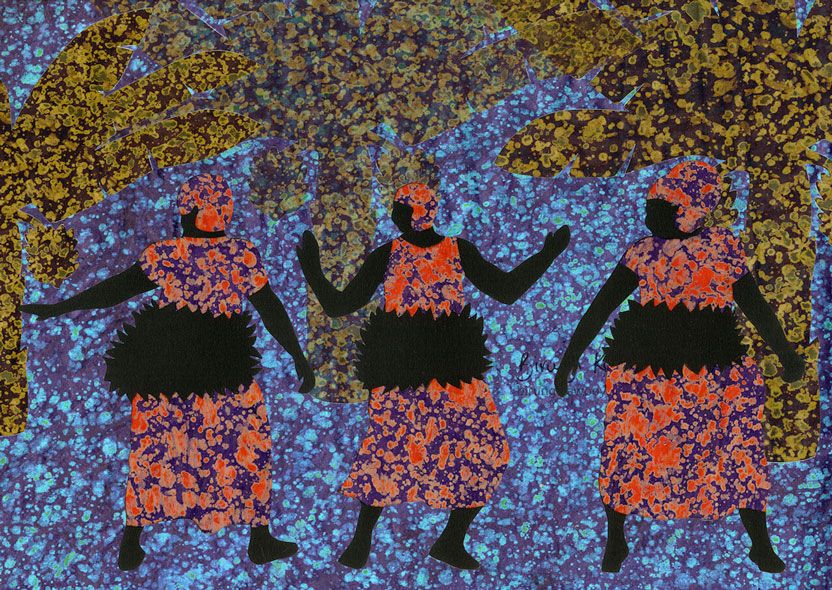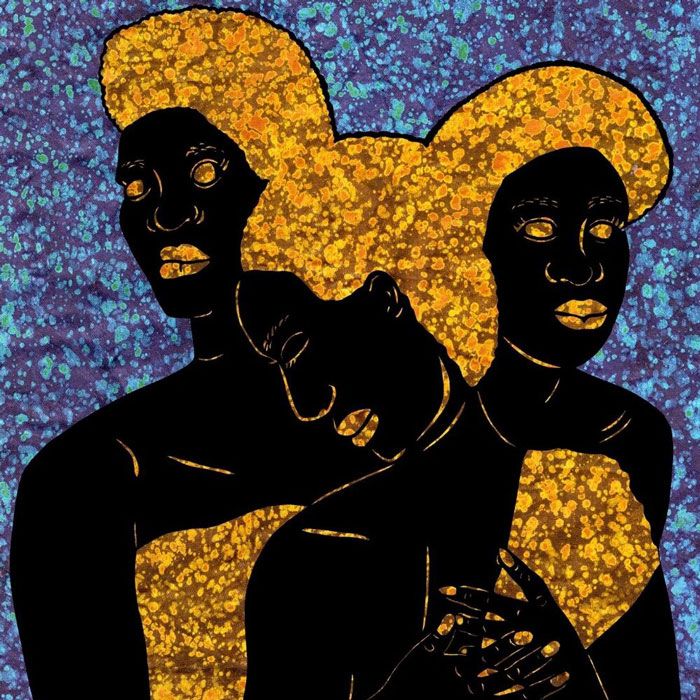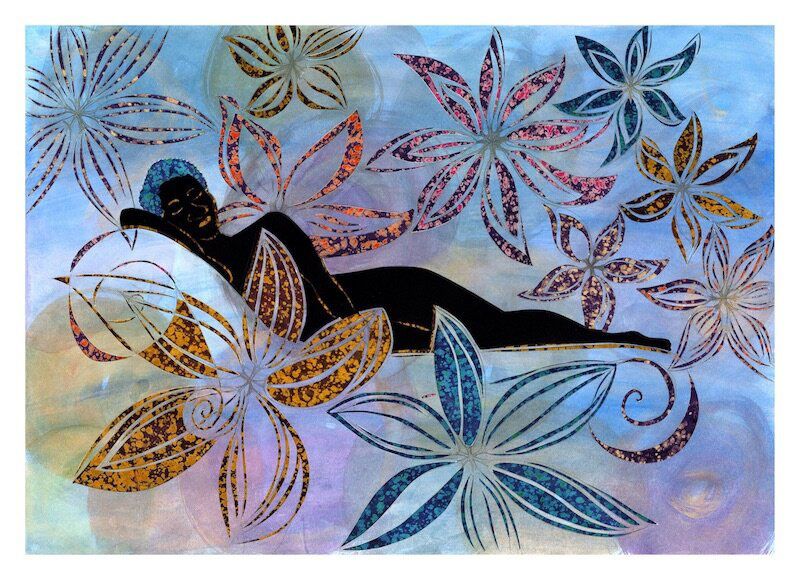Black Artistry Series is a year-round program committed to celebrating Black creatives and storytellers around the world. Each month, Arts Help is highlight impactful projects and publishing exclusive interviews with leaders who are producing inspiring content in support of the Black community. Through this program, we aim to cultivate a platform for these stories to be shared with readers around the world and to celebrate the talent and ingenuity of Black creatives.
This month, Arts Help had the pleasure of interviewing London-based artist Birungi Kawooya. Through the art of collage, Kawooya showcases the beauty of the African diaspora and her Ugandan heritage, while also highlighting the importance of well-being. In this interview, Kawooya talks about what led her to this point in her career, the need for positive representations of Black women and how mindfulness and rest have helped shape her artistic journey.
First, can you tell us a little bit about yourself and how you got started in the art of collage?
I got started with collage because I had the materials at home. I was just a bit bored one day and I happened to have lots of African print fabric, I had a craft knife, I had paper and glue, and I thought, let me just see if I can make something out of it. I think that’s why I really relate to collage because it’s really accessible. I didn’t go to art school, so I quite like that I’ve been able to make up intuitively my own collage technique.
That was about 8 or 9 years ago, but what I’ve realized in the past few years is that my style is very much influenced by the collage art that I had in my childhood home. My parents are from Uganda and a lot of the art there is made with banana tree fiber or Lubogo, which is a tree bark cloth. There’s lots of pictures at home of women, men, in kind of side profile silhouettes. Because they’re using natural fibers, it’s a one-colour palette, it’s quite natural, it’s earthy, it’s brown, and they’re also representing the Uganda people, my tribe. That’s just the artwork I grew up with, so I’ve always gravitated to keeping the people in my work Black as well. As an East African I’ve been politicized as Black, but I’m comfortable with that label, it’s fine. This is what I represent in my art.

You feature Ugandan classical dance styles as well as Ugandan batik fabrics in your work. Could you tell us more about the inspiration behind your pieces?
I create artwork that I want to see more of, and things I want to experience more of. I grew up with a big family and I always remember when my parents would have big parties and invite all their friends around, so those are really good fun memories that we had that I like to recreate [in] some of my pieces. I’ve also got lots of dance art and me and my sisters—my older sisters were really cool; they still are cool—we used to have kitchen discos. I didn’t feel as confident about my dancing as they did, so I think that’s also why I make dance art, because I’m really in awe of these incredible artists, incredible dancers from Africa or the African diaspora, who influence us all and just make us feel so good.
Another key scene is nature. Going to Uganda when I was younger and also the spaces I lived in, in South East London where I grew up, were always really green and that’s really important to me. It just makes me feel relaxed and I like to incorporate especially banana leaves or trees in my work, it’s just really soothing. But the key theme really is Black women. I grew up with lots of sisters, my mother is an incredible single mother, and I just want us to have more positive representations of us, but also representations that are honest.
There’s so much more that I want to showcase, different emotions. It’s not always joy; it’s not always dancing. I need to make room for my different emotional states as well.
In the past couple of years, I’ve been making a series of work called Sisters Need Sleep and that’s a message to myself, one I want to share with people. Because in the lockdown period it was really difficult for all of us, and I found my mental health declining, but I wasn’t aware of this. It was actually something that was pointed out to me, that I’m a bit different. I think emotionally I was just quite flat and not really feeling different emotional states, and then it got worse, and I kept on working through it. I just kept on like a machine, just trying to keep up in my past full-time job and not stopping and saying, Birungi, you know you have a history of anxiety and depression, should you see a therapist? Should you work part-time? Should you be asking for help? By the time I did, my workplace decided that they didn’t want to keep me anymore, which was the best decision actually. But I need to remind myself that I am not a machine and if I am unwell, if I need to rest, if I need to take care of myself, if I need to slow down, that’s okay, that’s allowed.
I’ve got a body of work that’s growing, and it’ll probably never stop growing, because I really want to remind myself and to support other Black women to rest and to show us in those states. We don’t just have to be taking care of children, happy, joyous. There’s so much more to our humanity, so I want to add to that to support my well-being and also to invite others to support theirs as well. I’m very much inspired by Black women and their experiences.
Your art is very connected to the idea of well-being. You state on your website: “My artistic journey of self expression leads me on a path towards joy, healing and rest.” Could you tell us more about that?
When my body is telling me I need to do something, I need to honour that. If my body is tired, if I feel like my eyes are tired and need a rest, not calling myself lazy, not to beat myself up and say that that’s wrong and that’s not correct. Because my body just wants to take care of me and it sends me lots of signals and messages, and it’s my responsibility to listen to them. There are so many distractions in the world and contractual obligations and familial demands and global movements and uprisings, and there’s only 24 hours in a day and it can seem overwhelming. But I’ve got to be honest, if I’m not able, how am I going to be of help to my brother, my organization, other artistic colleagues, if I’m not treating myself well and with kindness and with fairness. Because if we want a more, if I want to contribute to a world that is fairer and kinder, more equitable, I need to start with myself because then I’ll be able to do that, to model that with other people.
Also, I’ve been reading a lot of really interesting, not just theory but practice, about how often the most marginalized people, the ones that face lots of intersections, the poorer people, people with disabilities—I have a mental health condition, I consider myself disabled—those who are racialized, people that live in the global south, gender as well, if you’re queer, if you are at those intersections there’s so much going against you. But with that knowledge, that’s where the solutions lie. Because they understand what it’s like to be taken advantage of and to be treated unfairly, they understand how you work together to support everybody, because they’re people that have the intersections of race, gender, class, and these are the people we need to be listening to. It can feel overwhelming, but I think if we go inside, if we just take a breath and try to connect to our minds and bodies, that’s the starting off place to be in community and communing with other people. That’s what my artwork is compelling people to do by supporting and creating sights of rest. We need to have had enough sleep to be able to cooperate.

You also host Mindful African Workshops. What are they and where did the idea behind them come from?
Because I’m a self-taught artist and I understand what it is to experience anxiety, and I understand that collage is really accessible and allows for imagination, and for beginners who don’t consider themselves creative to engage—I was looking for a job for about 7 months and midway into that I said to myself, why don’t I just bring some friends around and we can collage together? It’ll be fun to be together. Being an artist can be solitary, but I thought let’s just come together.
I helped them to make some artwork in about 90 minutes to 2 hours and they had the funnest time and I did too. I felt like I must keep doing this because I feel good, they feel good, and they feel proud of themselves as well which I really like. I want people to have self-esteem and to challenge limiting negative self-thoughts that say you’re not creative, because I understand that as well. I feel there’s something quite magical that happens when you come together and it’s that thing about communion, we can’t do this alone, we’re stronger when we’re together.
I start the class with a meditation to clear our minds and then we do some drawing exercises. It’s quite funny, everyone laughs and gets to relax, and then I ask them about what they want to make, and they ask me, how do I do this? I can tell them it’s going to be like twenty-seven steps, but I just say, let’s take it a step at a time, this is what you should look at first, this is what you should pick up, and how does this material look to you, what could this represent in your portrait, for instance. You can’t figure everything out right now. It’s ok that you don’t know how you’re going to get from this blank page to this portrait or this landscape, this scene, but use your imagination, ask me questions, learn from each other, and then together we’ll build that and it’s really joyous. It’s one of the best feelings, actually, to help people make artwork from their minds; it’s always a beautiful feeling. It feels like a way to practice being together, trusting each other and experimenting.
Also, what I love is that people get to relate to the African prints and they can even imagine themselves in different colour hair, different coulour skin. If they’re doing self-portraits, which I love for people to do, particularly because self-portraiture is reserved for the elite, the upper-class, it helps people feel important and to consider themselves as worthy of being a work of art. I wanted to turn the past workshop into a time travel series where I help people to represent their past, their present and their future over a course so that we can process things, and also look toward the future and say, this is where I want to be, and imagine yourself in the National Portrait Gallery. Who’s that person, what have they done, work towards that goal. But I think there’s also a lot of value in looking back at the past and representing that, coming to terms with what has happened in our lives as a way of art therapy.
You collaborate with organizations such as Sistah Space. Can you talk about why that is important for you?
Sistah Space are an organization, one of the few organizations in the UK, that is dedicated to supporting women and children in violence situations and understanding their culture, and understanding how bruises show up, because often they’re not visible and they’re not believed by the emergency services. Sistah Space are a fantastic organization campaigning for specialist care to women of African heritage who have suffered violence. When you’re in a financially precarious situation, when you don’t have the funds and the money and the freedom to leave dangerous situations, you find yourself vulnerable. I haven’t been in that situation but I have had some periods of unemployment and it makes me think, if I’m lucky enough to be able to make artwork, and even during my unemployment stage, be able to have a roof over my head and be safe, I should give back.
These organizations are underfunded, they’re not supported by our governments and councils enough and we’re ignored. Black women go missing and their deaths aren’t reported as suspicious. We’re not given the sympathy and care that a woman who has blue eyes and blond hair would if she went missing, and quite rightly she should be given that support. Sistah Space supports everybody.
It’s just devastating when you’re at those intersections of race, class, gender, sexuality and that help is not given. You’re the most vulnerable, but you’re given the least support.
So that’s why it’s important for me to have supported Sistah Space, because it could be me, it could be my friends.

What do you hope to convey with your work? Why do you create art?
I make my work to express myself. When I was younger, I had some difficult encounters with my father, and it meant that I didn’t feel safe saying what I wanted to say out loud. That’s something I took on into adulthood and I found myself getting bullied at work, afraid of situations, and not standing up for myself. I feel like my artwork allows me to speak and communicate what I want to express, but also to process my emotions and moods and past.
In September I’m going to Uganda for three months, [it’s] the first time I would’ve been there for the longest time period outside of being a toddler and I’m really excited. I’m designing my own residency with Njabala Foundation which is directed by Martha Kazungu. She’s going to exhibit my artwork and what I’m hoping to do beyond learning how to paint on the bark, learning to weave, which are artforms in Uganda, and using banana leaves fiber in my collages, the main reason why I want to spend time in Uganda is, because I’m based in London, I’m away from my culture and that’s really important for me to express.
I’m looking forward to creating this time-travelling series where I’m getting to represent my past but also to reimagine it and say this is how I would’ve wanted things to have gone for me. I want to represent my present and show myself with all these ways of communicating and expressing because I’m going to learn all these different techniques. I won’t rely on just one type of collage, I’m going to be using banana fiber, tree fiber, and weaving, and painting, and I’m now doing a sculpture. Most importantly, I’m going to look at my future and just be so bold, because this past year which started off with me being fired has just—I didn’t expect to be here, so I’m just going to keep dreaming. The reason I make my work is to help me, to inspire me, to imagine something better. Just dream out loud and be optimistic, which is fundamentally the opposite from depression and anxiety so I’m flexing my anxious mind which imagines already, but imagines the worst, and I’m flipping it to imagine what I want to create. I’m doing that for myself and hopefully it will inspire others also to take that time out to dream
Birungi Kawooya is currently painting a globe sculpture for The World Reimagined charity, which aims to change how we understand the impact of the Transatlantic Slave Trade.
She is also raising funds for her artistic residency in Uganda. Her curator, Martha Kazungu of Njabala Foundation is exhibiting her art in March 2023. You can learn more about Njabala Foundation here.
You can learn more about the work of Birungi Kawooya on her website and follow her on Instagram.
Read other editions of the Black Artistry Series here, and follow the series on social media with the hashtag #ArtsHelp365
